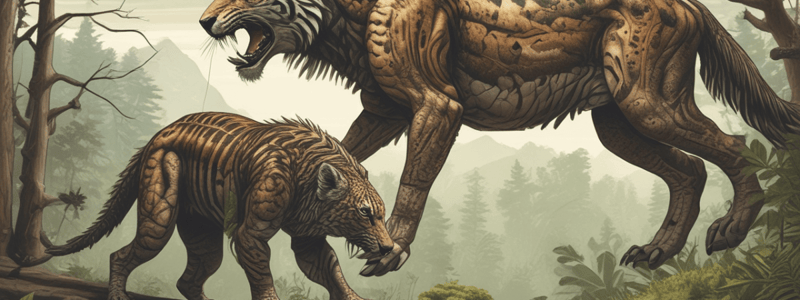Podcast
Questions and Answers
In a predator-prey dynamic, how do predators regulate prey populations?
In a predator-prey dynamic, how do predators regulate prey populations?
Predators regulate prey populations by maintaining ecosystem balance.
What is an example of an adaptation that prey may evolve to avoid predation?
What is an example of an adaptation that prey may evolve to avoid predation?
Camouflage, speed, and other defense mechanisms.
What is the outcome when one species outcompetes another for a limited resource?
What is the outcome when one species outcompetes another for a limited resource?
Competitive exclusion, leading to population decline or extinction.
What is an example of a mutualistic relationship?
What is an example of a mutualistic relationship?
How do species adapt to coexist in the same ecosystem?
How do species adapt to coexist in the same ecosystem?
What is an example of habitat segregation?
What is an example of habitat segregation?
What is the outcome when species compete for the same resource?
What is the outcome when species compete for the same resource?
What is an example of interference competition?
What is an example of interference competition?
How do predators adapt to overcome prey defenses?
How do predators adapt to overcome prey defenses?
What is a mechanism of habitat segregation?
What is a mechanism of habitat segregation?
What is the primary consequence of competitive exclusion in a resource competition scenario?
What is the primary consequence of competitive exclusion in a resource competition scenario?
How do prey populations respond to increased predator populations in a predator-prey cycle?
How do prey populations respond to increased predator populations in a predator-prey cycle?
What is the benefit of the clownfish in its mutualistic relationship with the sea anemone?
What is the benefit of the clownfish in its mutualistic relationship with the sea anemone?
What is the primary mechanism by which species coexist despite competing for resources in a spatial segregation scenario?
What is the primary mechanism by which species coexist despite competing for resources in a spatial segregation scenario?
What is the realized niche of a species, and how does it differ from the fundamental niche?
What is the realized niche of a species, and how does it differ from the fundamental niche?
What is the outcome of resource competition when multiple species adapt to use the same resource in different ways?
What is the outcome of resource competition when multiple species adapt to use the same resource in different ways?
How do predator populations respond to decreased prey populations in a predator-prey cycle?
How do predator populations respond to decreased prey populations in a predator-prey cycle?
What is the benefit of the pollinator in its mutualistic relationship with the flower?
What is the benefit of the pollinator in its mutualistic relationship with the flower?
What is the primary mechanism by which species coexist despite competing for resources in a temporal segregation scenario?
What is the primary mechanism by which species coexist despite competing for resources in a temporal segregation scenario?
What is the result of niche partitioning in a resource competition scenario?
What is the result of niche partitioning in a resource competition scenario?
Flashcards are hidden until you start studying
Study Notes
Ecological Niches and Species Relations
Predator-Prey Dynamics
- Definition: Interaction between predators (species that hunt and feed on others) and prey (species being hunted)
- Key aspects:
- Predators regulate prey populations, maintaining ecosystem balance
- Prey evolve defense mechanisms (e.g., camouflage, speed) to avoid predation
- Predators adapt hunting strategies to overcome prey defenses
- Examples:
- Lion-zebra interaction in savannas
- Wolf-moose interaction in forests
Resource Competition
- Definition: Competition between species for limited resources (e.g., food, water, light)
- Types of competition:
- Exploitative competition: Species compete for a shared resource
- Interference competition: Species directly interfere with each other's access to resources
- Outcomes:
- Competitive exclusion: One species outcompetes another for a resource, leading to population decline or extinction
- Resource partitioning: Species adapt to use different resources or use the same resource at different times
Mutualism
- Definition: Symbiotic relationship in which both species benefit
- Examples:
- Clownfish-anemone mutualism: Clownfish receive protection from anemone's stinging cells, while anemone benefits from clownfish cleaning and nutrients
- Flower-pollinator mutualism: Flowers provide nectar to pollinators, which facilitate pollen transfer and plant reproduction
Habitat Segregation
- Definition: Different species occupy distinct habitats or microhabitats within an ecosystem
- Mechanisms:
- Niche partitioning: Species specialize in specific habitats or resources
- Habitat selection: Species choose habitats based on environmental factors (e.g., light, temperature, moisture)
- Examples:
- Tree species segregation in forests (e.g., deciduous vs. coniferous trees)
- Coral reef species zonation (e.g., shallow vs. deep water dwellers)
Coexistence Mechanisms
- Definition: Mechanisms allowing multiple species to coexist in the same ecosystem
- Types:
- Niche differentiation: Species occupy distinct ecological niches
- Temporal segregation: Species use resources at different times
- Spatial segregation: Species occupy different spatial areas
- Examples:
- Coexistence of multiple bird species in a forest, each occupying distinct niches (e.g., forest floor, canopy)
- Diel vertical migration in aquatic ecosystems, where species migrate to different depths at different times
Ecological Niches and Species Relations
Predator-Prey Dynamics
- Predators regulate prey populations, maintaining ecosystem balance
- Prey evolve defense mechanisms, such as camouflage and speed, to avoid predation
- Predators adapt hunting strategies to overcome prey defenses
- Examples of predator-prey interactions include lion-zebra and wolf-moose
Resource Competition
- Competition between species for limited resources, such as food, water, and light
- Exploitative competition: Species compete for a shared resource
- Interference competition: Species directly interfere with each other's access to resources
- Competitive exclusion: One species outcompetes another for a resource, leading to population decline or extinction
- Resource partitioning: Species adapt to use different resources or use the same resource at different times
Mutualism
- Symbiotic relationship in which both species benefit
- Examples of mutualism include clownfish-anemone and flower-pollinator relationships
- Clownfish receive protection from anemone's stinging cells, while anemone benefits from clownfish cleaning and nutrients
- Flowers provide nectar to pollinators, which facilitate pollen transfer and plant reproduction
Habitat Segregation
- Different species occupy distinct habitats or microhabitats within an ecosystem
- Niche partitioning: Species specialize in specific habitats or resources
- Habitat selection: Species choose habitats based on environmental factors, such as light, temperature, and moisture
- Examples of habitat segregation include tree species segregation in forests and coral reef species zonation
Coexistence Mechanisms
- Mechanisms allowing multiple species to coexist in the same ecosystem
- Niche differentiation: Species occupy distinct ecological niches
- Temporal segregation: Species use resources at different times
- Spatial segregation: Species occupy different spatial areas
- Examples of coexistence mechanisms include coexistence of multiple bird species in a forest and diel vertical migration in aquatic ecosystems
Ecological Niches and Species Relations
Resource Competition
- Two or more species competing for the same limited resource (e.g., food, water, light) leads to resource competition
- Resource competition can result in:
- Competitive exclusion: one species outcompetes another, leading to local extinction
- Resource partitioning: species adapt to use different resources or use the same resource in different ways
Predator-prey Dynamics
- Predators: species that hunt and feed on others
- Prey: species that are hunted and fed upon
- Predator-prey cycles: predator populations increase when prey populations are high, and vice versa
- Predator populations decrease when prey populations are low, and vice versa
Mutualism
- Interaction between two species where both benefit
- Examples of mutualism:
- Clownfish and sea anemone: clownfish receives protection, anemone receives cleaning
- Flower and pollinator: flower receives pollination, pollinator receives food
Coexistence Mechanisms
- Mechanisms that enable species to coexist despite competing for resources
- Coexistence mechanisms include:
- Niche partitioning: species use different resources or use the same resource in different ways
- Spatial segregation: species occupy different spatial areas
- Temporal segregation: species occupy the same area but at different times
Realized Niche
- The actual environment and resources used by a species
- Realized niche differs from the fundamental niche, which is the potential environment and resources a species could use
- Realized niche is often smaller than the fundamental niche due to competition and other interactions with other species
Studying That Suits You
Use AI to generate personalized quizzes and flashcards to suit your learning preferences.




